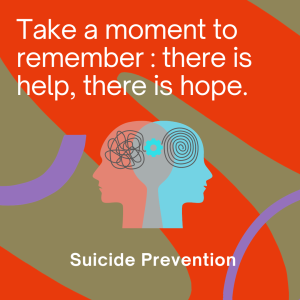In Singapore, suicide is the leading cause of death for those aged between 10 to 29 years. There are many dangerous misconceptions about suicide out there that can hinder us from recognising the warning signs. The bottomline is that suicide is preventable – more often than not, individuals do not actually want to end their lives. It is important that we educate ourselves on the issue so that we can help those in need of support; it can sometimes mean the difference between life and death. If you know someone who may be facing a crisis or are going through one yourself, do seek help.
MYTH: SUICIDE IS ALWAYS CAUSED BY DEPRESSION
FACT: There is more to suicide than depression.
Two out of every three people who commit suicide are depressed at the time that they take their lives and severe depression is the diagnosis that is most commonly associated with suicide. However, to say that depression is the sole cause of all suicides is certainly an overgeneralization. Suicide is the result of a combination, progression or repetition of a series of distressing life events. While depression is often one of the many stressors that people struggle with, people who do not suffer from depression could possibly still be at risk of suicide. Similarly, not everyone dealing with depression dies by suicide.

MYTH: SUICIDE IS RARE AND NOT A CONCERN IN SINGAPOR
FACT: Suicide in Singapore is very real.
As mentioned earlier, suicide is the leading cause of death for those between the ages of 10 and 29. A total of 429 people took their own lives in 2016, and over the last five years there have been 2.4 times as many suicides as transport accidents. These staggering statistics may not even be the worst of it – because of the constraints in classifying a death as suicide, reported statistics
may not be an accurate reflection of the situation.
The number of people who attempt suicide is also a significant proportion that is even harder to capture. Suicide is therefore a very real concern in Singapore even though it may not seem like it.
MYTH: TALKING ABOUT SUICIDE WILL ENCOURAGE SUICIDE ATTEMPTS
FACT: Talking about it can help.
Many are afraid that talking about suicide or asking someone if they are suicidal will put ideas in their head and push them further towards suicide. However, the truth is that talking about it provides the opportunity for open communication. Fears that are shared aloud with trusted people are more likely to diminish. The first step to encouraging a suicidal person to live is to talk about their feelings – verbalising their emotions and struggles could in fact provide them a huge sense of relief. Talking about it also shows them that you care about them and want them to live. Do not underestimate the impact that this simple act can have on someone’s life.
MYTH: ONCE A PERSON DECIDES TO COMMIT SUICIDE, THERE IS NOTHING YOU CAN DO
FACT: The right help at the right time is crucial.
The fact of the matter is that people can always be helped and suicides can be prevented. In fact, in many cases, suicidal crises may be relatively short-lived. Suicide is a permanent solution to what is typically a temporary problem and reminding the person of this can go a long way to help them. Practical help should be offered immediately, for instance keeping the person company, encouraging them to share their feelings and helping them to build plans for the future – this can help to distract them and even avert their intention to either attempt or to complete the suicide. While immediate help is invaluable at the time of a crisis, do note that appropriate counselling will have to be given in the long term.
MYTH: PEOPLE WHO THREATEN SUICIDE ARE JUST SEEKING ATTENTION AND SHOULD NOT BE TAKEN SERIOUSLY
FACT: The attention may just save their lives.
Any and all suicide attempts must be taken seriously and treated as though the person has the intent to end their lives. Never dismiss a suicide attempt as a facade to simply gain attention. In many cases, it is highly likely that the person has tried to gain attention before and this attention is crucial – it may just be the thing that saves them. Do not neglect a cry for help.
MYTH: SUICIDAL PEOPLE WANT TO DIE
FACT: Most suicidal people just want to get out of their situation and do not see any other way out.
The majority of suicidal individuals do not in fact want to die. They often tend to fluctuate between wanting to live and wanting to die. Those who contemplate suicide are usually overwhelmed by a sense of helplessness and despair. The truth is that they no longer want to live the life that they have and want to put an end to all their pain and suffering. This does not mean that they actually want their lives to end.
MYTH: SUICIDES HAPPEN WITHOUT WARNING
FACT: Suicides do not usually happen out of the blue – there are many warning signs.
People contemplating suicide would usually make their intentions known to others in one way or another. The warning signs are not always obvious; but just because you did not spot the signs, it does not mean that they do not exist. For fear of being judged by others, suicidal individuals usually communicate their intentions in more indirect ways.
HERE ARE SOME COMMON WARNING SIGNS TO LOOK OUT FOR:
- The recent suicide or death of a friend or relative
- Previous suicide attempts
- Depression, conduct disorder and problems with adjustment such as substance abuse
- Giving away prized possessions or making other final arrangements such as a will
- Dramatic changes in sleep patterns
- Extreme changes in eating habits
- Withdrawal from friends and family
- Dropping out of group activities
- Personality changes such as outbursts of anger, impulsive behaviour or apathy about health
- Easily irritable
- Unexplained crying
- Lack of interest in the future
MYTH: A SUDDEN LIFTING OF SPIRITS IN SOMEONE WHO HAS DISPLAYED SUICIDAL TENDENCIES MEANS THAT THE SUICIDE RISK IS OVER
FACT: The opposite may be true.
A marked and sudden improvement in the mental state of someone who has attempted suicide previously or someone who has been in a depressive period could actually be an indication that the person has made a firm decision to commit suicide. It is this decision to end their lives that could be making them feel better in the present.
MYTH: SUICIDE IS HEREDITARY
FACT: Suicide is not something that is inherited.
Although the incidences of suicide can be over- represented in families, it is not something that can be inherited genetically. The fact is that the members of a family all share the same emotional environment and this can influence their decisions significantly. The completed suicide of one family member for instance may raise the awareness of suicide as an option for other family members. However, it goes without saying that families (and also friends) often play a significant role in preventing suicide – strong social support has been proven to lower suicide risk.

MYTH: ONLY PEOPLE WITH MENTAL DISORDERS ARE SUICIDAL
FACT: Not everyone who attempts suicide has a mental disorder.
Suicidal behaviour is usually an indication of a deep sense of unhappiness. It is not necessarily a sign of mental disorder. There are many people living with mental disorders who have not displayed any sort of suicidal behaviour and there are also people who have taken their own lives and have not had any sort of mental disorders.
MYTH: SUICIDAL PEOPLE ARE ALWAYS ANGRY WHEN SOMEONE INTERVENES AND THEY WILL RESENT THAT PERSON AFTERWARDS
FACT: Most suicidal individuals will be grateful for the intervention.
It is common for suicidal individuals, especially those of a younger age, to be defensive and to resist any help offered to them in the initial stages. However, in most cases, this behaviour is merely a barrier that is imposed upon others to test how much they truly care and whether they are truly prepared to help. In fact, for most adolescents who consider suicide, it often
a huge relief to know that someone sincerely cares about them and to be able to share their pain and their emotional burden with another person. When asked later, the majority of them will express gratitude for the timely intervention that helped save their lives.
MYTH: PEOPLE OF A LOWER SOCIOECONOMIC STATUS ARE MORE LIKELY TO ATTEMPT SUICIDE
FACT: Suicide is a public health issue that transcends socioeconomic statuses.
The assumption behind this myth is that those with greater wealth have lesser problems and therefore have fewer reasons to take their lives. However, the rate at which celebrity suicides occur should be an indication that this is not true. Suicide is a public health concern that cuts across SES boundaries – it can affect anyone.
NEED HELP?
24-hours HELPLINE (SOS): 1-767
WEBSITE: https://www.sos.org.sg/











